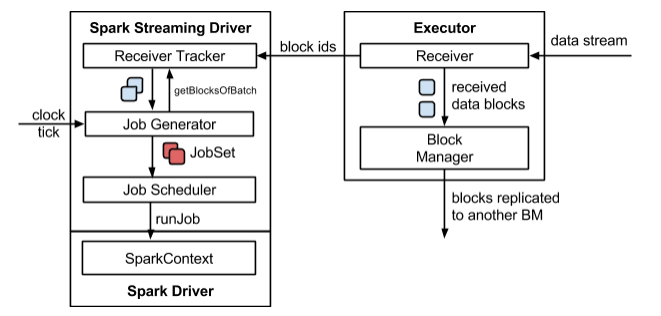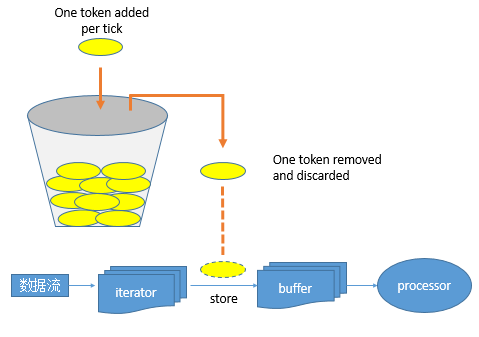Spark Streaming Backpressure分析
1、为什么引入Backpressure
默认情况下,Spark Streaming通过Receiver以生产者生产数据的速率接收数据,计算过程中会出现batch processing time > batch interval的情况,其中batch processing time 为实际计算一个批次花费时间, batch interval为Streaming应用设置的批处理间隔。这意味着Spark Streaming的数据接收速率高于Spark从队列中移除数据的速率,也就是数据处理能力低,在设置间隔内不能完全处理当前接收速率接收的数据。如果这种情况持续过长的时间,会造成数据在内存中堆积,导致Receiver所在Executor内存溢出等问题(如果设置StorageLevel包含disk, 则内存存放不下的数据会溢写至disk, 加大延迟)。Spark 1.5以前版本,用户如果要限制Receiver的数据接收速率,可以通过设置静态配制参数“spark.streaming.receiver.maxRate”的值来实现,此举虽然可以通过限制接收速率,来适配当前的处理能力,防止内存溢出,但也会引入其它问题。比如:producer数据生产高于maxRate,当前集群处理能力也高于maxRate,这就会造成资源利用率下降等问题。为了更好的协调数据接收速率与资源处理能力,Spark Streaming 从v1.5开始引入反压机制(back-pressure),通过动态控制数据接收速率来适配集群数据处理能力。
2、Backpressure
Spark Streaming Backpressure: 根据JobScheduler反馈作业的执行信息来动态调整Receiver数据接收率。通过属性“spark.streaming.backpressure.enabled”来控制是否启用backpressure机制,默认值false,即不启用。
2.1 Streaming架构如下图所示(详见Streaming数据接收过程文档和Streaming 源码解析)

2.2 BackPressure执行过程如下图所示:
在原架构的基础上加上一个新的组件RateController,这个组件负责监听“OnBatchCompleted”事件,然后从中抽取processingDelay 及schedulingDelay信息. Estimator依据这些信息估算出最大处理速度(rate),最后由基于Receiver的Input Stream将rate通过ReceiverTracker与ReceiverSupervisorImpl转发给BlockGenerator(继承自RateLimiter).

3、BackPressure 源码解析
3.1 RateController类体系
RatenController 继承自StreamingListener. 用于处理BatchCompleted事件。核心代码为:
**
* A StreamingListener that receives batch completion updates, and maintains
* an estimate of the speed at which this stream should ingest messages,
* given an estimate computation from a `RateEstimator`
*/
private[streaming] abstract class RateController(val streamUID: Int, rateEstimator: RateEstimator)
extends StreamingListener with Serializable {
……
…… /**
* Compute the new rate limit and publish it asynchronously.
*/
private def computeAndPublish(time: Long, elems: Long, workDelay: Long, waitDelay: Long): Unit =
Future[Unit] {
val newRate = rateEstimator.compute(time, elems, workDelay, waitDelay)
newRate.foreach { s =>
rateLimit.set(s.toLong)
publish(getLatestRate())
}
}
def getLatestRate(): Long = rateLimit.get() override def onBatchCompleted(batchCompleted: StreamingListenerBatchCompleted) {
val elements = batchCompleted.batchInfo.streamIdToInputInfo
for {
processingEnd <- batchCompleted.batchInfo.processingEndTime
workDelay <- batchCompleted.batchInfo.processingDelay
waitDelay <- batchCompleted.batchInfo.schedulingDelay
elems <- elements.get(streamUID).map(_.numRecords)
} computeAndPublish(processingEnd, elems, workDelay, waitDelay)
}
}
3.2 RateController的注册
JobScheduler启动时会抽取在DStreamGraph中注册的所有InputDstream中的rateController,并向ListenerBus注册监听. 此部分代码如下:
def start(): Unit = synchronized {
if (eventLoop != null) return // scheduler has already been started
logDebug("Starting JobScheduler")
eventLoop = new EventLoop[JobSchedulerEvent]("JobScheduler") {
override protected def onReceive(event: JobSchedulerEvent): Unit = processEvent(event)
override protected def onError(e: Throwable): Unit = reportError("Error in job scheduler", e)
}
eventLoop.start()
// attach rate controllers of input streams to receive batch completion updates
for {
inputDStream <- ssc.graph.getInputStreams
rateController <- inputDStream.rateController
} ssc.addStreamingListener(rateController)
listenerBus.start()
receiverTracker = new ReceiverTracker(ssc)
inputInfoTracker = new InputInfoTracker(ssc)
receiverTracker.start()
jobGenerator.start()
logInfo("Started JobScheduler")
}
3.3 BackPressure执行过程分析
BackPressure 执行过程分为BatchCompleted事件触发时机和事件处理两个过程
3.3.1 BatchCompleted触发过程
对BatchedCompleted的分析,应该从JobGenerator入手,因为BatchedCompleted是批次处理结束的标志,也就是JobGenerator产生的作业执行完成时触发的,因此进行作业执行分析。
Streaming 应用中JobGenerator每个Batch Interval都会为应用中的每个Output Stream建立一个Job, 该批次中的所有Job组成一个Job Set.使用JobScheduler的submitJobSet进行批量Job提交。此部分代码结构如下所示
/** Generate jobs and perform checkpoint for the given `time`. */
private def generateJobs(time: Time) {
// Set the SparkEnv in this thread, so that job generation code can access the environment
// Example: BlockRDDs are created in this thread, and it needs to access BlockManager
// Update: This is probably redundant after threadlocal stuff in SparkEnv has been removed.
SparkEnv.set(ssc.env) // Checkpoint all RDDs marked for checkpointing to ensure their lineages are
// truncated periodically. Otherwise, we may run into stack overflows (SPARK-6847).
ssc.sparkContext.setLocalProperty(RDD.CHECKPOINT_ALL_MARKED_ANCESTORS, "true")
Try {
jobScheduler.receiverTracker.allocateBlocksToBatch(time) // allocate received blocks to batch
graph.generateJobs(time) // generate jobs using allocated block
} match {
case Success(jobs) =>
val streamIdToInputInfos = jobScheduler.inputInfoTracker.getInfo(time)
jobScheduler.submitJobSet(JobSet(time, jobs, streamIdToInputInfos))
case Failure(e) =>
jobScheduler.reportError("Error generating jobs for time " + time, e)
}
eventLoop.post(DoCheckpoint(time, clearCheckpointDataLater = false))
}
其中,sumitJobSet会创建固定数量的后台线程(具体由“spark.streaming.concurrentJobs”指定),去处理Job Set中的Job. 具体实现逻辑为:
def submitJobSet(jobSet: JobSet) {
if (jobSet.jobs.isEmpty) {
logInfo("No jobs added for time " + jobSet.time)
} else {
listenerBus.post(StreamingListenerBatchSubmitted(jobSet.toBatchInfo))
jobSets.put(jobSet.time, jobSet)
jobSet.jobs.foreach(job => jobExecutor.execute(new JobHandler(job)))
logInfo("Added jobs for time " + jobSet.time)
}
}
其中JobHandler用于执行Job及处理Job执行结果信息。当Job执行完成时会产生JobCompleted事件. JobHandler的具体逻辑如下面代码所示:
private class JobHandler(job: Job) extends Runnable with Logging {
import JobScheduler._
def run() {
try {
val formattedTime = UIUtils.formatBatchTime(
job.time.milliseconds, ssc.graph.batchDuration.milliseconds, showYYYYMMSS = false)
val batchUrl = s"/streaming/batch/?id=${job.time.milliseconds}"
val batchLinkText = s"[output operation ${job.outputOpId}, batch time ${formattedTime}]"
ssc.sc.setJobDescription(
s"""Streaming job from <a href="$batchUrl">$batchLinkText</a>""")
ssc.sc.setLocalProperty(BATCH_TIME_PROPERTY_KEY, job.time.milliseconds.toString)
ssc.sc.setLocalProperty(OUTPUT_OP_ID_PROPERTY_KEY, job.outputOpId.toString)
// Checkpoint all RDDs marked for checkpointing to ensure their lineages are
// truncated periodically. Otherwise, we may run into stack overflows (SPARK-6847).
ssc.sparkContext.setLocalProperty(RDD.CHECKPOINT_ALL_MARKED_ANCESTORS, "true")
// We need to assign `eventLoop` to a temp variable. Otherwise, because
// `JobScheduler.stop(false)` may set `eventLoop` to null when this method is running, then
// it's possible that when `post` is called, `eventLoop` happens to null.
var _eventLoop = eventLoop
if (_eventLoop != null) {
_eventLoop.post(JobStarted(job, clock.getTimeMillis()))
// Disable checks for existing output directories in jobs launched by the streaming
// scheduler, since we may need to write output to an existing directory during checkpoint
// recovery; see SPARK-4835 for more details.
PairRDDFunctions.disableOutputSpecValidation.withValue(true) {
job.run()
}
_eventLoop = eventLoop
if (_eventLoop != null) {
_eventLoop.post(JobCompleted(job, clock.getTimeMillis()))
}
} else {
// JobScheduler has been stopped.
}
} finally {
ssc.sc.setLocalProperty(JobScheduler.BATCH_TIME_PROPERTY_KEY, null)
ssc.sc.setLocalProperty(JobScheduler.OUTPUT_OP_ID_PROPERTY_KEY, null)
}
}
}
}
当Job执行完成时,向eventLoop发送JobCompleted事件。EventLoop事件处理器接到JobCompleted事件后将调用handleJobCompletion 来处理Job完成事件。handleJobCompletion使用Job执行信息创建StreamingListenerBatchCompleted事件并通过StreamingListenerBus向监听器发送。实现如下:
private def handleJobCompletion(job: Job, completedTime: Long) {
val jobSet = jobSets.get(job.time)
jobSet.handleJobCompletion(job)
job.setEndTime(completedTime)
listenerBus.post(StreamingListenerOutputOperationCompleted(job.toOutputOperationInfo))
logInfo("Finished job " + job.id + " from job set of time " + jobSet.time)
if (jobSet.hasCompleted) {
jobSets.remove(jobSet.time)
jobGenerator.onBatchCompletion(jobSet.time)
logInfo("Total delay: %.3f s for time %s (execution: %.3f s)".format(
jobSet.totalDelay / 1000.0, jobSet.time.toString,
jobSet.processingDelay / 1000.0
))
listenerBus.post(StreamingListenerBatchCompleted(jobSet.toBatchInfo))
}
job.result match {
case Failure(e) =>
reportError("Error running job " + job, e)
case _ =>
}
}
3.3.2、BatchCompleted事件处理过程
StreamingListenerBus将事件转交给具体的StreamingListener,因此BatchCompleted将交由RateController进行处理。RateController接到BatchCompleted事件后将调用onBatchCompleted对事件进行处理。
override def onBatchCompleted(batchCompleted: StreamingListenerBatchCompleted) {
val elements = batchCompleted.batchInfo.streamIdToInputInfo
for {
processingEnd <- batchCompleted.batchInfo.processingEndTime
workDelay <- batchCompleted.batchInfo.processingDelay
waitDelay <- batchCompleted.batchInfo.schedulingDelay
elems <- elements.get(streamUID).map(_.numRecords)
} computeAndPublish(processingEnd, elems, workDelay, waitDelay)
}
onBatchCompleted会从完成的任务中抽取任务的执行延迟和调度延迟,然后用这两个参数用RateEstimator(目前存在唯一实现PIDRateEstimator,proportional-integral-derivative (PID) controller, PID控制器)估算出新的rate并发布。代码如下:
/**
* Compute the new rate limit and publish it asynchronously.
*/
private def computeAndPublish(time: Long, elems: Long, workDelay: Long, waitDelay: Long): Unit =
Future[Unit] {
val newRate = rateEstimator.compute(time, elems, workDelay, waitDelay)
newRate.foreach { s =>
rateLimit.set(s.toLong)
publish(getLatestRate())
}
}
其中publish()由RateController的子类ReceiverRateController来定义。具体逻辑如下(ReceiverInputDStream中定义):
/**
* A RateController that sends the new rate to receivers, via the receiver tracker.
*/
private[streaming] class ReceiverRateController(id: Int, estimator: RateEstimator)
extends RateController(id, estimator) {
override def publish(rate: Long): Unit =
ssc.scheduler.receiverTracker.sendRateUpdate(id, rate)
}
publish的功能为新生成的rate 借助ReceiverTracker进行转发。ReceiverTracker将rate包装成UpdateReceiverRateLimit事交ReceiverTrackerEndpoint
/** Update a receiver's maximum ingestion rate */
def sendRateUpdate(streamUID: Int, newRate: Long): Unit = synchronized {
if (isTrackerStarted) {
endpoint.send(UpdateReceiverRateLimit(streamUID, newRate))
}
}
ReceiverTrackerEndpoint接到消息后,其将会从receiverTrackingInfos列表中获取Receiver注册时使用的endpoint(实为ReceiverSupervisorImpl),再将rate包装成UpdateLimit发送至endpoint.其接到信息后,使用updateRate更新BlockGenerators(RateLimiter子类),来计算出一个固定的令牌间隔。
/** RpcEndpointRef for receiving messages from the ReceiverTracker in the driver */
private val endpoint = env.rpcEnv.setupEndpoint(
"Receiver-" + streamId + "-" + System.currentTimeMillis(), new ThreadSafeRpcEndpoint {
override val rpcEnv: RpcEnv = env.rpcEnv override def receive: PartialFunction[Any, Unit] = {
case StopReceiver =>
logInfo("Received stop signal")
ReceiverSupervisorImpl.this.stop("Stopped by driver", None)
case CleanupOldBlocks(threshTime) =>
logDebug("Received delete old batch signal")
cleanupOldBlocks(threshTime)
case UpdateRateLimit(eps) =>
logInfo(s"Received a new rate limit: $eps.")
registeredBlockGenerators.asScala.foreach { bg =>
bg.updateRate(eps)
}
}
})
其中RateLimiter的updateRate实现如下:
/**
* Set the rate limit to `newRate`. The new rate will not exceed the maximum rate configured by
* {{{spark.streaming.receiver.maxRate}}}, even if `newRate` is higher than that.
*
* @param newRate A new rate in events per second. It has no effect if it's 0 or negative.
*/
private[receiver] def updateRate(newRate: Long): Unit =
if (newRate > 0) {
if (maxRateLimit > 0) {
rateLimiter.setRate(newRate.min(maxRateLimit))
} else {
rateLimiter.setRate(newRate)
}
}
setRate的实现 如下:
public final void setRate(double permitsPerSecond) {
Preconditions.checkArgument(permitsPerSecond > 0.0
&& !Double.isNaN(permitsPerSecond), "rate must be positive");
synchronized (mutex) {
resync(readSafeMicros());
double stableIntervalMicros = TimeUnit.SECONDS.toMicros(1L) / permitsPerSecond; //固定间隔
this.stableIntervalMicros = stableIntervalMicros;
doSetRate(permitsPerSecond, stableIntervalMicros);
}
}
到此,backpressure反压机制调整rate结束。
4.流量控制点
当Receiver开始接收数据时,会通过supervisor.pushSingle()方法将接收的数据存入currentBuffer等待BlockGenerator定时将数据取走,包装成block. 在将数据存放入currentBuffer之时,要获取许可(令牌)。如果获取到许可就可以将数据存入buffer, 否则将被阻塞,进而阻塞Receiver从数据源拉取数据。
/**
* Push a single data item into the buffer.
*/
def addData(data: Any): Unit = {
if (state == Active) {
waitToPush() //获取令牌
synchronized {
if (state == Active) {
currentBuffer += data
} else {
throw new SparkException(
"Cannot add data as BlockGenerator has not been started or has been stopped")
}
}
} else {
throw new SparkException(
"Cannot add data as BlockGenerator has not been started or has been stopped")
}
}
其令牌投放采用令牌桶机制进行, 原理如下图所示:

令牌桶机制: 大小固定的令牌桶可自行以恒定的速率源源不断地产生令牌。如果令牌不被消耗,或者被消耗的速度小于产生的速度,令牌就会不断地增多,直到把桶填满。后面再产生的令牌就会从桶中溢出。最后桶中可以保存的最大令牌数永远不会超过桶的大小。当进行某操作时需要令牌时会从令牌桶中取出相应的令牌数,如果获取到则继续操作,否则阻塞。用完之后不用放回。
Streaming 数据流被Receiver接收后,按行解析后存入iterator中。然后逐个存入Buffer,在存入buffer时会先获取token,如果没有token存在,则阻塞;如果获取到则将数据存入buffer. 然后等价后续生成block操作。
转载请注明:http://www.cnblogs.com/barrenlake/p/5349949.html
Spark Streaming Backpressure分析的更多相关文章
- Spark源码系列(八)Spark Streaming实例分析
这一章要讲Spark Streaming,讲之前首先回顾下它的用法,具体用法请参照<Spark Streaming编程指南>. Example代码分析 val ssc = )); // 获 ...
- <Spark><Spark Streaming><作业分析><JobHistory>
Intro 这篇是对一个Spark (Streaming)作业的log进行分析.用来加深对Spark application运行过程,优化空间的各种理解. Here to Start 从我这个初学者写 ...
- Spark Streaming之四:Spark Streaming 与 Kafka 集成分析
前言 Spark Streaming 诞生于2013年,成为Spark平台上流式处理的解决方案,同时也给大家提供除Storm 以外的另一个选择.这篇内容主要介绍Spark Streaming 数据接收 ...
- Spark Streaming性能优化: 如何在生产环境下应对流数据峰值巨变
1.为什么引入Backpressure 默认情况下,Spark Streaming通过Receiver以生产者生产数据的速率接收数据,计算过程中会出现batch processing time > ...
- 4. Spark Streaming解析
4.1 初始化StreamingContext import org.apache.spark._ import org.apache.spark.streaming._ val conf = new ...
- Spark Streaming的优化之路—从Receiver到Direct模式
作者:个推数据研发工程师 学长 1 业务背景 随着大数据的快速发展,业务场景越来越复杂,离线式的批处理框架MapReduce已经不能满足业务,大量的场景需要实时的数据处理结果来进行分析.决 ...
- Spark Streaming数据限流简述
Spark Streaming对实时数据流进行分析处理,源源不断的从数据源接收数据切割成一个个时间间隔进行处理: 流处理与批处理有明显区别,批处理中的数据有明显的边界.数据规模已知:而流处理数 ...
- Spark Streaming实践和优化
发表于:<程序员>杂志2016年2月刊.链接:http://geek.csdn.net/news/detail/54500 作者:徐鑫,董西成 在流式计算领域,Spark Streamin ...
- Spark Streaming 调优指南
SparkStreaming是架构在SparkCore上的一个"应用",SparkStreaming主要由DStreamGraph.Job的生成.数据的接收和导入以及容错四大模块组 ...
随机推荐
- linux awk命令详解【转载】
本文转载自:http://www.cnblogs.com/ggjucheng/archive/2013/01/13/2858470.html 简介 awk是一个强大的文本分析工具,相对于grep的查找 ...
- supervisor:进程管理工具
一,安装(任何一种方式) apt-get install supervisor easy_install supervisor pip install supervisor 二,配置 配置superv ...
- Asp.Net Mvc+Angular.Js自测小Demo
参考:http://www.cnblogs.com/eedc/p/6082052.html 一.引用anguler: 1.angular.js 2.angular-route.js 3.app.js ...
- 加入gitignore文件没有起作用怎么办
步骤一: 假设有未提交的文件先提交到Git. 步骤二: 在Git根文件夹下运行以下的Git命令: git rm -r --cached . git add . git commit -m " ...
- mysql 变量set
在游标循环中,使用使用select into 变量var时,再判断var isnull 或者length(var)=0时,跳出循环. 解决方式: 使用set var=(select id from t ...
- UITableView的编辑(插入、删除、移动)
先说两个方法beginUpdates和endUpdates,几点注意事项: 一般我们把行.块的插入.删除.移动写在由这两个方法组成的函数块中.如果你不是在这两个函数组成的块中调用插入.删除.移动方法, ...
- 【移动开发】Android中将我们平时积累的工具类打包
Android开发的组件打包成JAR安装包,通过封闭成JAR包,可以重复利用,非常有利于扩展和减少工作重复性.这里为了讲解方便,我用了之前的一个代码框架中核心部分,不了解的可以回头看一下:http:/ ...
- yii console.php 报错 Property "CConsoleApplication.theme" is not defined.
默认配置的话,是不会出现这个错误的,应该是有人为修改了 yiic.php 这个文件,本来是 $config 载入的应该是 console.php ,人为修改后载入了 main.php 这个配置文件了 ...
- PYCURL ERROR 22 - "The requested URL returned error: 403 Forbidden"
RHEL6.5创建本地Yum源后,发现不可用,报错如下: [root@namenode1 html]# yum install gcc Loaded plugins: product-id, refr ...
- Python 中 open()文件操作的方式
Python的open方法用来打开一个文件.第一个参数是文件的位置和文件名,第二个参数是读写模式: f=open('/1.txt','w') 读写模式的类型有: rU 或 Ua 以读方式打开, 同时提 ...
